Assessment of Soybean Lodging Using UAV Imagery and Machine Learning
Abstract
1. Introduction
- Imbalanced dataset processing: This study has contributed by outlining the methods used for texture feature extraction, preprocessing of imbalanced datasets, including image feature extraction, feature selection, and applying various resampling techniques such as SMOTE-Tomek Link, Synthetic Minority Oversampling-Edited Nearest Neighbor (SMOTE-ENN), Borderline-SMOTE, Synthetic Minority Oversampling-Nominal Continuous (SMOTE-NC), and Adaptive Synthetic (ADASYN) to address the class imbalance issue in the lodging dataset.
- Efficient lodging assessment for soybean breeding: For the first time, evaluated the potential and methods to assess the lodging score of soybean breeding lines in field conditions using UAV-based imagery and machine learning.
2. Results
2.1. Feature Selection
2.2. Original and Balanced Dataset
2.3. Classification Performance of Machine Learning Models
Classification Performance of Four Machine Learning Models Using Original and SMOTE-ENN Dataset
3. Discussion
Future Work
4. Materials and Methods
4.1. Field Experiment
4.2. Ground Data Collection
4.3. UAV Imagery Data Collection
4.4. Image Processing
4.5. Texture Feature Extraction and Selection
4.6. Preprocess Imbalanced Data
4.7. Machine Learning Models for Soybean Lodging Classification
4.8. Data Analysis and Accuracy Assessment
5. Conclusions
Supplementary Materials
Author Contributions
Funding
Data Availability Statement
Acknowledgments
Conflicts of Interest
References
- Barrett, J. Corn and Soybean Production up in 2021, USDA Reports, Corn and Soybean Stocks up from Year Earlier, Winter Wheat Seedings up for 2022. United States Department of Agriculture, National Agricultural Statistics Service: Washington, DC, USA, 2022. Available online: https://www.nass.usda.gov (accessed on 28 February 2023).
- Veas, R.E.A.; Ergo, V.V.; Vega, C.R.C.; Lascano, R.H.; Rondanini, D.P.; Carrera, C.S. Soybean seed growth dynamics exposed to heat and water stress during the filling period under field conditions. J. Agron. Crop Sci. 2021, 208, 472–485. [Google Scholar] [CrossRef]
- Fehr, W.R.; Caviness, C.E.; Burmood, D.T.; Pennington, J.S. Stage of Development Descriptions for Soybeans, Glycine Max (L.) Merrill. Crop Sci. 1971, 11, 929–931. [Google Scholar] [CrossRef]
- Woods, S.J.; Swearingin, M.L. Influence of simulated early lodging upon soybean seed yield and its components. Agron. J. 1977, 69, 239–242. [Google Scholar] [CrossRef]
- Saito, K.; Nishimura, K.; Kitahara, T. Effect on lodging on seed yield of field-grown soybean—Artificial lodging and lodging preventing treatments. Jpn. J. Crop. Sci. 2012, 81, 27–32. [Google Scholar] [CrossRef]
- Kitabatake, T.; Yamaguchi, N.; Sayama, T.; Taguchi-Shiobara, F.; Suzuki, H.; Ishimoto, M.; Yoshihira, T. Morphological Traits Associated with the Quantitative Trait Locus for Lodging Tolerance in Soybean. Crop Sci. 2019, 59, 504–516. [Google Scholar] [CrossRef]
- Kato, S.; Cober, E.; O’Donoghue, L.; Morrison, M.J.; Rajcan, I. Phenotyped the materials, performed GWAS and complementary data analysis, and wrote the manuscript. Can. J. Plant Sci. 2020, 100, 1243–1252. [Google Scholar]
- Lodging of Soybean. 1 September 2021. Available online: https://www.dekalbasgrowdeltapine.com/en-us/agronomy/soybean-lodging.html (accessed on 19 June 2023).
- Vann, R.; Reisig, D.; Thiessen, L. Soybean Considerations Following Hurricane Florence. 19 September 2018. Available online: https://soybeans.ces.ncsu.edu/2018/09/soybean-considerations-following-hurricane-florence/ (accessed on 19 June 2023).
- Wu, W.; Ma, B.-L. A New Method for Assessing Plant Lodging and the Impact of Management Options on Lodging in Canola Crop Production. Sci. Rep. 2016, 6, 31890. [Google Scholar] [CrossRef]
- Tian, M.; Ban, S.; Yuan, T.; Ji, Y.; Ma, C.; Li, L. Assessing Rice Lodging Using UAV Visible and Multispectral Image. Int. J. Remote Sens. 2021, 42, 8840–8857. [Google Scholar] [CrossRef]
- Sun, Q.; Sun, L.; Shu, M.; Gu, X.; Yang, G.; Zhou, L. Monitoring Maize Lodging Grades via Unmanned Aerial Vehicle Multispectral Image. Plant Phenom. 2019, 2019, 5704154. [Google Scholar] [CrossRef]
- Zhang, C.; Walters, D.; Kovacs, J.M. Applications of Low Altitude Remote Sensing in Agriculture upon Farmers’ Requests: A Case Study in Northeastern Ontario, Canada. PLoS ONE 2014, 9, e112894. [Google Scholar] [CrossRef]
- Vlachopoulos, O.; Leblon, B.; Wang, J.; Haddadi, A.; LaRocque, A.; Patterson, G. Mapping Barley Lodging with UAS Multispectral Imagery and Machine Learning. ISPRS Int. Arch. Photogramm. Remote Sens. Spatial Inf. Sci. 2021, XLIII-B1-2021, 553–560. [Google Scholar] [CrossRef]
- Zhou, J.; Zhou, J.; Ye, H.; Ali, M.L.; Nguyen, H.T.; Chen, P. Classification of Soybean Leaf Wilting Due to Drought Stress Using UAV-Based Imagery. Comput. Electron. Agr. 2020, 175, 105576. [Google Scholar] [CrossRef]
- Bagherzadi, L. Assessing Physiological Mechanisms to Elucidate the Slow-Wilting Trait in Soybean Genotypes. Ph.D. Thesis, North Carolina State University, Raleigh, NC, USA, 2017. [Google Scholar]
- Berry, P.; Spink, J.; Sylvester-Bradley, R.; Pickett, A.; Sterling, M.; Baker, C.; Cameron, N. Lodging Control through Variety Choice and Management. In Proceedings of the 8th Home-Grown Cereals Association R & D Conference on Cereals and Oilseeds, Harrogate, UK, 9–10 January 2002; pp. 7.1–7.12. [Google Scholar]
- Sishodia, R.P.; Ray, R.L.; Singh, S.K. Applications of Remote Sensing in Precision Agriculture: A Review. Remote Sens. 2020, 12, 3136. [Google Scholar] [CrossRef]
- Santosh, K.M.; Sundaresan, J.; Roggem, R.; Déri, A.; Singh, R.P. Geospatial Technologies and Climate Change; Springer International Publishing: Dordrecht, The Netherlands, 2014. [Google Scholar]
- Nowatzki, J.; Andres, R.; Kyllo, K. Agricultural Remote Sensing Basics. NDSU Extension Service Publication. 2004. Available online: www.ag.ndsu.nodak.edu (accessed on 21 July 2023).
- Chang, C.Y.; Zhou, R.; Kira, O.; Marri, S.; Skovira, J.; Gu, L.; Sun, Y. An Unmanned Aerial System (UAS) for concurrent measurements of solar induced chlorophyll fluorescence and hyperspectral reflectance toward improving crop monitoring. Agric. For. Meteorol. 2020, 294, 108145. [Google Scholar] [CrossRef]
- Nagasubramanian, K.; Jones, S.; Singh, A.K.; Sarkar, S.; Singh, A.; Ganapathysubramanian, B. Plant disease identifcation using explainable 3D deep learning on hyperspectral images. Plant Methods 2019, 15, 98. [Google Scholar] [CrossRef]
- Chlingaryan, A.; Sukkarieh, S.; Whelan, B. Machine learning approaches for crop yield prediction and nitrogen status estimation in precision agriculture: A review. Comput. Electron. Agric. 2018, 151, 61–69. [Google Scholar] [CrossRef]
- Yang, G.; Liu, J.; Zhao, C.; Li, Z.; Huang, Y.; Yu, H.; Zhu, X.; Singh, R.P. Unmanned Aerial Vehicle Remote Sensing for Field-Based Crop Phenotyping: Current Status and Perspectives. Front. Plant Sci. 2017, 8, 1111. [Google Scholar] [CrossRef] [PubMed]
- Al-Tamimi, N.; Langan, P.; Bernád, V.; Walsh, J.; Mangina, E.; Negrão, S. Capturing Crop Adaptation to Abiotic Stress Using Image-Based Technologies. Open Biol. 2022, 12, 210353. [Google Scholar] [CrossRef]
- Yousfi, S.; Marín, J.; Parra, L.; Lloret, J.; Mauri, P.V. Remote sensing devices as key methods in the advanced turfgrass phenotyping under different water regimes, Agric. Water Man. 2022, 266, 107581. [Google Scholar] [CrossRef]
- Zhou, J.; Chen, H.; Zhou, J.; Fu, X.; Ye, H.; Nguyen, H.T. Development of an Automated Phenotyping Platform for Quantifying Soybean Dynamic Responses to Salinity Stress in Greenhouse Environment. Comput. Electron. Agr. 2018, 151, 319–330. [Google Scholar] [CrossRef]
- Sugiura, R.; Tsuda, S.; Tamiya, S.; Itoh, A.; Nishiwaki, K.; Murakami, N.; Shibuya, Y.; Hirafuji, M.; Nuske, S. Field phenotyping system for the assessment of potato late blight resistance using RGB imagery from an unmanned aerial vehicle. Biosyst. Eng. 2016, 148, 1–10. [Google Scholar] [CrossRef]
- Teodoro, P.E.; Teodoro, L.P.R.; Baio, F.H.R.; da Silva Junior, C.A.; dos Santos, R.G.; Ramos, A.P.M.; Pinheiro, M.M.F.; Osco, L.P.; Gonçalves, W.N.; Carneiro, A.M.; et al. Predicting Days to Maturity, Plant Height, and Grain Yield in Soybean: A Machine and Deep Learning Approach Using Multispectral Data. Remote Sens. 2021, 13, 4632. [Google Scholar] [CrossRef]
- Díaz-Varela, R.A.; de la Rosa, R.; León, L.; Zarco-Tejada, P.J. High-Resolution Airborne UAV Imagery to Assess Olive Tree Crown Parameters Using 3D Photo Reconstruction: Application in Breeding Trials. Remote Sens. 2015, 7, 4213–4232. [Google Scholar] [CrossRef]
- Zhou, J.; Yungbluth, D.; Vong, C.N.; Scaboo, A.; Zhou, J.J.R. Estimation of the Maturity Date of Soybean Breeding Lines Using UAV-Based Multispectral Imagery. Remote Sens. 2019, 11, 2075. [Google Scholar] [CrossRef]
- Duan, T.; Chapman, S.C.; Guo, Y.; Zhen, B. Dynamic Monitoring of NDVI in Wheat Agronomy and Breeding Trials Using an Unmanned Aerial Vehicle. Field Crops Res. 2017, 210, 71–80. [Google Scholar] [CrossRef]
- Bai, H.; Purcell, L.C. Aerial Canopy Temperature Differences between Fast- and Slow-Wilting Soya Bean Genotypes. J. Agron. Crop Sci. 2018, 204, 243–251. [Google Scholar] [CrossRef]
- Rajapaksa, S.; Eramian, M.; Duddu, H.; Wang, M.; Shirtliffe, S.; Ryu, S.; Josuttes, A.; Zhang, T.; Vail, S.; Pozniak, C.; et al. Classification of Crop Lodging with Gray Level Co-Occurrence Matrix. In Proceedings of the 2018 IEEE Winter Conference on Applications of Computer Vision (WACV), Lake Tahoe, NV, USA; 2018; pp. 251–258. [Google Scholar] [CrossRef]
- Mardanisamani, S.; Maleki, F.; Kassani, S.H.; Rajapaksa, S.; Duddu, H.; Wang, M.; Shirtliffe, S.; Ryu, S.; Josuttes, A.; Zhang, T.; et al. Crop Lodging Prediction from UAV-Acquired Images of Wheat and Canola Using a DCNN Augmented with Handcrafted Texture Features. Remote Sens. 2019, 11, 2657. [Google Scholar] [CrossRef]
- Mausda, R.; Nomura, K.; Iida, M.; Suguri, M. Detection of Rice Plant Lodging Using Camera and Laser Range Finder. In Proceedings of the Information Technology Automation and Precision Farming, International Conference of Agricultural Engineering—CIGR-AgEng 2012: Agriculture and Engineering for a Healthier Life, Valencia, Spain, 8–12 July 2012. [Google Scholar]
- Liu, L.; Wang, J.; Song, X.; Li, C.; Huang, W.; Zhao, C. The Canopy Spectral Features and Remote Sensing of Wheat Lodging. J. Remote Sens. 2005, 9, 323–327. [Google Scholar]
- Chauhan, S.; Darvishzadeh, R.; Lu, Y.; Stroppiana, D.; Boschetti, M.; Pepe, M.; Nelson, A.D. Wheat Lodging Assessment Using Multispectral UAV Data. In Proceedings of the ISPRS Geospatial Week Volume XLII-2/W13, 2019 ISPRS Geospatial Week 2019, Enschede, The Netherlands, 10–14 June 2019. [Google Scholar]
- Liu, H.Y.; Yang, G.J.; Zhu, H.C. The Extraction of Wheat Lodging Area in UAV’s Image Used Spectral and Texture Features. Appl. Mech. Mater. 2014, 651–653, 2390–2393. [Google Scholar] [CrossRef]
- Yang, M.; Huang, K.; Kuo, Y.; Tsai, H.P.; Lin, L. Spatial and Spectral Hybrid Image Classification for Rice Lodging Assessment through UAV Imagery. Remote Sens. 2017, 9, 583. [Google Scholar] [CrossRef]
- Han, L.; Yang, G.; Feng, H.; Zhou, C.; Yang, H.; Xu, B.; Li, Z.; Yang, X. Quantitative Identification of Maize Lodging-Causing Feature Factors Using Unmanned Aerial Vehicle Images and a Nomogram Computation. Remote Sens. 2018, 10, 1528. [Google Scholar] [CrossRef]
- Liu, T.; Li, R.; XiaoChun, Z.; Jiang, M.; Jin, X.; Zhou, P.; Liu, S.; Sun, C.; Guo, W. Estimates of rice lodging using indices derived from UAV visible and thermal infrared images. Agric. For. Meteorol. 2018, 252, 144–154. [Google Scholar] [CrossRef]
- Zhang, Z.; Flores, P.; Igathinathane, C.; Naik, D.L.; Kiran, R.; Ransom, J.K. Wheat Lodging Detection from UAS Imagery Using Machine Learning Algorithms. Remote Sens. 2020, 12, 1838. [Google Scholar] [CrossRef]
- Batista, G.E.A.P.A.; Prati, R.C.; Monard, M.C. A study of the behavior of several methods for balancing machine learning training data. ACM SIGKDD Explorations Newsletter. 2004, 6, 20–29. [Google Scholar] [CrossRef]
- Zhou, C.; Gong, Y.; Fang, S.; Yang, K.; Peng, Y.; Wu, X.; Zhu, R. Combining spectral and wavelet texture features for unmanned aerial vehicles remote estimation of rice leaf area index. Front. Plant Sci. 2022, 13, 957870. [Google Scholar] [CrossRef] [PubMed]
- Wu, W.; Shah, F.; Ma, B.L. Understanding of crop lodging and agronomic strategies to improve the resilience of rapeseed production to climate change. Crop and Env. 2022, 1, 133–144. [Google Scholar] [CrossRef]
- Han, L.; Yang, G.; Yang, X.; Song, X.; Xu, B.; Li, Z.; Wu, J.; Yang, H.; Wu, J. An explainable XGBoost model improved by SMOTE-ENN technique for maize lodging detection based on multi-source unmanned aerial vehicle images. Comput. Electron. Agric. 2022, 194, 106804. [Google Scholar] [CrossRef]
- Chemchem, A.; Alin, F.; Krajecki, M. Combining SMOTE Sampling and Machine Learning for Forecasting Wheat Yields in France. In Proceedings of the 2019 IEEE Second International Conference on Artificial Intelligence and Knowledge Engineering (AIKE), Sardinia, Italy, 3–5 June 2019; pp. 9–14. [Google Scholar] [CrossRef]
- Datta, D.; Mallick, P.K.; Shafi, J.; Choi, J.; Ijaz, M.F. Computational Intelligence for Observation and Monitoring: A Case Study of Imbalanced Hyperspectral Image Data Classification. Comput. Intell. Neurosci. 2022, 2022, 8735201. [Google Scholar] [CrossRef]
- Tan, S.; Mortensen, A.K.; Ma, X.; Boelt, B.; Gislum, R. Assessment of grass lodging using texture and canopy height distribution features derived from UAV visual-band images. Agric. For. Meteorol. 2021, 308, 108541. [Google Scholar] [CrossRef]
- Liu, Z.; Li, C.; Wang, Y.; Huang, W.; Ding, X.; Zhou, B.; Wu, H.; Wang, D.; Shi, J. Comparison of Spectral Indices and Principal Component Analysis for Differentiating Lodged Rice Crop from Normal Ones. In Proceedings of the Computer and Computing Technologies in Agriculture V. CCTA 2011, IFIP Advances in Information and Communication Technology, Beijing, China, 29–31 October 2011; Springer: Berlin/Heidelberg, Germany, 2012; Volume 369. [Google Scholar] [CrossRef]
- Beck, M.W. Neural Net Tools: Visualization and analysis tools for neural networks. J. Stat. Soft. 2018, 85, 1–20. [Google Scholar] [CrossRef]
- Rubel, F.; Brugger, K.; Haslinger, K.; Auer, I. The Climate of the European Alps: Shift of Very High Resolution Köppen-Geiger Climate Zones 1800–2100. Meteorol. Z. 2017, 26, 115–125. [Google Scholar] [CrossRef]
- Whitaker, R.T. A Level-Set Approach to 3D Reconstruction from Range Data. Int. J. Comput. Vis. 1998, 29, 203–231. [Google Scholar] [CrossRef]
- Chan, T.F.; Vese, L.A. Active Contours Without Edges. In IEEE Transactions on Image Processing; IEEE: New York, NY, USA, 2001; Volume 10, pp. 266–277. [Google Scholar]
- Hall-Beyer, M. Practical Guidelines for Choosing GLCM Textures to Use in Landscape Classification Tasks over a Range of Moderate Spatial Scales. Int. J. Remote Sens. 2017, 38, 1312–1338. [Google Scholar] [CrossRef]
- Gao, C.C.; Hui, X.-W. GLCM-Based Texture Feature Extraction. Comput. Syst. Appl. 2010, 19, 195–198. [Google Scholar]
- Kwak, G.H.; Park, N.W. Impact of Texture Information on Crop Classification with Machine Learning and UAV Images. Appl. Sci. 2019, 9, 643. [Google Scholar] [CrossRef]
- Haralick, M.R. Textural Features for Image Classification. IEEE Trans. Syst. Man Cybern. 1973, 3, 610–621. [Google Scholar] [CrossRef]
- Singh, S.; Srivastava, D.; Agarwal, S. GLCM and Its Application in Pattern Recognition. In Proceedings of the 5th International Symposium on Computational and Business Intelligence (ISCBI), Bangkok, Thailand, 20–25 November 2017. [Google Scholar]
- Iqbal, N.; Mumtaz, R.; Shafi, U.; Zaidi, S.M. Gray level co-occurrence matrix (GLCM) texture-based crop classification using low altitude remote sensing platforms. PeerJ Comput. Sci. 2021, 7, e536. [Google Scholar] [CrossRef] [PubMed]
- Pinto, L.S.; Ray, A.; Reddy, M.U.; Perumal, P.; Aishwarya, P. Crop disease classification using texture analysis. In Proceedings of the 2016 IEEE International Conference on Recent Trends in Electronics, Information & Communication Technology (RTEICT), Bangalore, India, 20–21 May 2016; pp. 825–828. [Google Scholar] [CrossRef]
- Mekhalfa, F.; Yacef, F. Supervised learning for crop/weed classification based on color and texture features. arXiv 2021, arXiv:2106.10581. [Google Scholar]
- Akhtar, A.; Nazir, M.; Khan, S.A. Crop Classification using Feature Extraction from Satellite Imagery. In Proceedings of the 15th International Multitopic Conference (INMIC), Islamabad, Pakistan, 13–15 December 2012. [Google Scholar] [CrossRef]
- Moumni, A.; Lahrouni, A. Machine Learning-Based Classification for Crop-Type Mapping Using the Fusion of High-Resolution Satellite Imagery in a Semiarid Area. Scientifica 2021, 2021, 8810279. [Google Scholar] [CrossRef]
- Lu, D.; Hetrick, S.; Moran, E. Land cover classification in a complex urban-rural landscape with Quickbird imagery. Photogramm. Eng. Remote Sensing. 2010, 76, 1159–1168. [Google Scholar] [CrossRef]
- Park, B.; Chen, Y.R. Co-occurrence Matrix Texture Features of Multispectral Images on Poultry Carcasses. J. Agric. Engng Res. 2001, 78, 127–139. [Google Scholar] [CrossRef]
- Soares, J.V.; Rennó, C.D.; Formaggio, A.R.; Yanasse, C.C.F.; Frery, A.C. An investigation of the selection of texture features for crop discrimination using SAR imagery. Remote Sens. Env. 1997, 59, 234–247. [Google Scholar] [CrossRef]
- Yang, D.J.; Zhao, J.; Lan, Y.B.; Wen, Y.T.; Pan, F.J.; Cao, D.L.; Hu, C.X.; Guo, J.K. Research on farmland crop classification based on UAV multispectral remote sensing images. Int. J. Precis. Agric. Aviat. 2021, 4, 29–35. [Google Scholar] [CrossRef]
- Shearer, S.A.; Holmes, R.G. Plant identification using color co-occurrence matrices. Trans. ASAE 1990, 33, 1237–1244. [Google Scholar] [CrossRef]
- Zhou, Y.; Luo, J.; Feng, L.; Yang, Y.; Chen, Y.; Wu, W. Long-Short-Term-Memory-Based Crop Classification Using High-Resolution Optical Images and Multi-Temporal SAR Data. GIScience Remote Sens. 2019, 56, 1170–1191. [Google Scholar] [CrossRef]
- Genuer, R.; Poggi, J.M.; Tuleau-Malot, C. VSURF: An R package for variable selection using random forests. R J. 2015, 7, 19–33. [Google Scholar] [CrossRef]
- Amirruddin, A.D.; Muharam, F.M.; Ismail, M.H.; Tan, N.P.; Ismail, M.F. Synthetic Minority Over-sampling TEchnique (SMOTE) and Logistic Model Tree (LMT)-Adaptive Boosting algorithms for classifying imbalanced datasets of nutrient and chlorophyll sufficiency levels of oil palm (Elaeis guineensis) using spectroradiometers and unmanned aerial vehicles. Comp. Electron. Agric. 2022, 193, 106646. [Google Scholar] [CrossRef]
- He, H.; Garcia, E.A. Learning from imbalanced data. In IEEE Transactions on Knowledge and Data Engineering; IEEE: New York, NY, USA, 2009; Volume 21, pp. 1263–1284. [Google Scholar]
- Skryjomski, P.; Krawczyk, B. Influence of Minority Class Instance Types on SMOTE Imbalanced Data Oversampling. Proc. Mach. Learn. Res. 2017, 74, 7–21. [Google Scholar]
- Fernández, A.; García, S.; Herrera, F.; Chawla, N.V. SMOTE for Learning from Imbalanced Data: Progress and Challenges, Marking the 15-year Anniversary. J. Artif. Intell. Res. 2018, 61, 863–905. [Google Scholar] [CrossRef]
- Zeng, M.; Zou, B.; Wei, F.; Liu, X.; Wang, L. Effective prediction of three common diseases by combining SMOTE with Tomek links technique for imbalanced medical data. In Proceedings of the 2016 IEEE International Conference of Online Analysis and Computing Science (ICOACS), Chongqing, China, 28–29 May 2016. [Google Scholar]
- Ai-Jun, L.; Peng, Z. Research on Unbalanced Data Processing Algorithm Base Tomek links-Smote. In Proceedings of the AIPR ‘20: Proceedings of the 2020 3rd International Conference on Artificial Intelligence and Pattern Recognition, Xiamen, China, 26–28 June 2020; pp. 13–17. [Google Scholar]
- Shi, X.; Tingyu, Q.; Gijs, V.P.; Marjan, V.D.A.; Bart, D.M. A Resampling Method to Improve the Prognostic Model of End-Stage Kidney Disease: A Better Strategy for Imbalanced Data. Front. Med. 2022, 9, 730748. [Google Scholar] [CrossRef]
- Gao, Q.; Jin, X.; Xia, E.; Wu, X.; Gu, L.; Yan, H.; Xia, Y.; Li, S. Identification of Orphan Genes in Unbalanced Datasets Based on Ensemble Learning. Front. Genet. 2020, 11. [Google Scholar] [CrossRef] [PubMed]
- Rashu, R.I.; Haq, N.; Rahman, R.M. Data mining approaches to predict final grade by overcoming class imbalance problem. In Proceedings of the 2014 17th International Conference on Computer and Information Technology (ICCIT), Dhaka, Bangladesh, 22–23 December 2014; IEEE: Piscataway, NJ, USA, 2014; pp. 14–19. [Google Scholar]
- Chawla, N.V.; Bowyer, K.W.; Hall, L.O.; Kegelmeyer, W.P. SMOTE: Synthetic minority oversampling technique. J. Artif. Intell. Res. 2002, 16, 321–357. [Google Scholar] [CrossRef]
- Taghizadeh-Mehrjardi, R.; Schmidt, K.; Eftekhari, K. Synthetic resampling strategies and machine learning for digital soil mapping in Iran. Eur. J. Soil Sci. 2020, 71, 352–368. [Google Scholar] [CrossRef]
- He, H.; Bai, Y.; Garcia, E.A.; Li, S. ADASYN: Adaptive synthetic sampling approach for imbalanced learning. In Proceedings of the IEEE International Joint Conference on Neural Networks (IEEE World Congress on Computational Intelligence), Hong Kong, China, 1–8 June 2008; IEEE Press: Piscataway, NJ, USA, 2008; pp. 1322–1328. [Google Scholar]
- Cisty, M.; Soldanova, V. Flow prediction versus flow simulation using machine learning algorithms. In Advances in Intelligent Data Analysis XVII; Perner, P., Ed.; Springer: Berlin/Heidelberg, Germany, 2018; pp. 369–382. [Google Scholar]
- Georganos, S.; Grippa, T.; Vanhuysse, S.; Lennert, M.; Shimoni, M.; Wolff, E. Very high-resolution object-based land use-land cover urban classification using extreme gradient boosting. IEEE Geosci. Remote. 2018, 15, 607–611. [Google Scholar] [CrossRef]
- Zhu, N.; Zhu, C.; Zhou, L.; Zhu, Y.; Zhang, X. Optimization of the Random Forest Hyperparameters for Power Industrial Control Systems Intrusion Detection Using an Improved Grid Search Algorithm. Appl. Sci. 2022, 12, 10456. [Google Scholar] [CrossRef]
- Uddin, S.; Haque, I.; Lu, H.; Moni, M.A.; Gide, E. Comparative performance analysis of K-nearest neighbour (KNN) algorithm and its different variants for disease prediction. Sci. Rep. 2022, 12, 6256. [Google Scholar] [CrossRef]
- Murthy, C.; Raju, P.; Badrinath, K. Classification of wheat crop with multi-temporal images: Performance of maximum likelihood and artificial neural networks. Int. J. Remote Sens. 2003, 24, 4871–4890. [Google Scholar] [CrossRef]
- Wang, H.; Zhang, J.; Xiang, K.; Liu, Y. Classification of remote sensing agricultural image by using artificial neural network. In Proceedings of the 2009 International Workshop on Intelligent Systems and Applications, Wuhan, China, 23–24 May 2009. [Google Scholar]
- Vieira, C.C.; Sarkar, S.; Tian, F.; Zhou, J.; Jarquin, D.; Nguyen, H.T.; Zhou, J.; Chen, P. Differentiate Soybean Response to Off-Target Dicamba Damage Based on UAV Imagery and Machine Learning. Remote Sens. 2022, 14, 1618. [Google Scholar] [CrossRef]
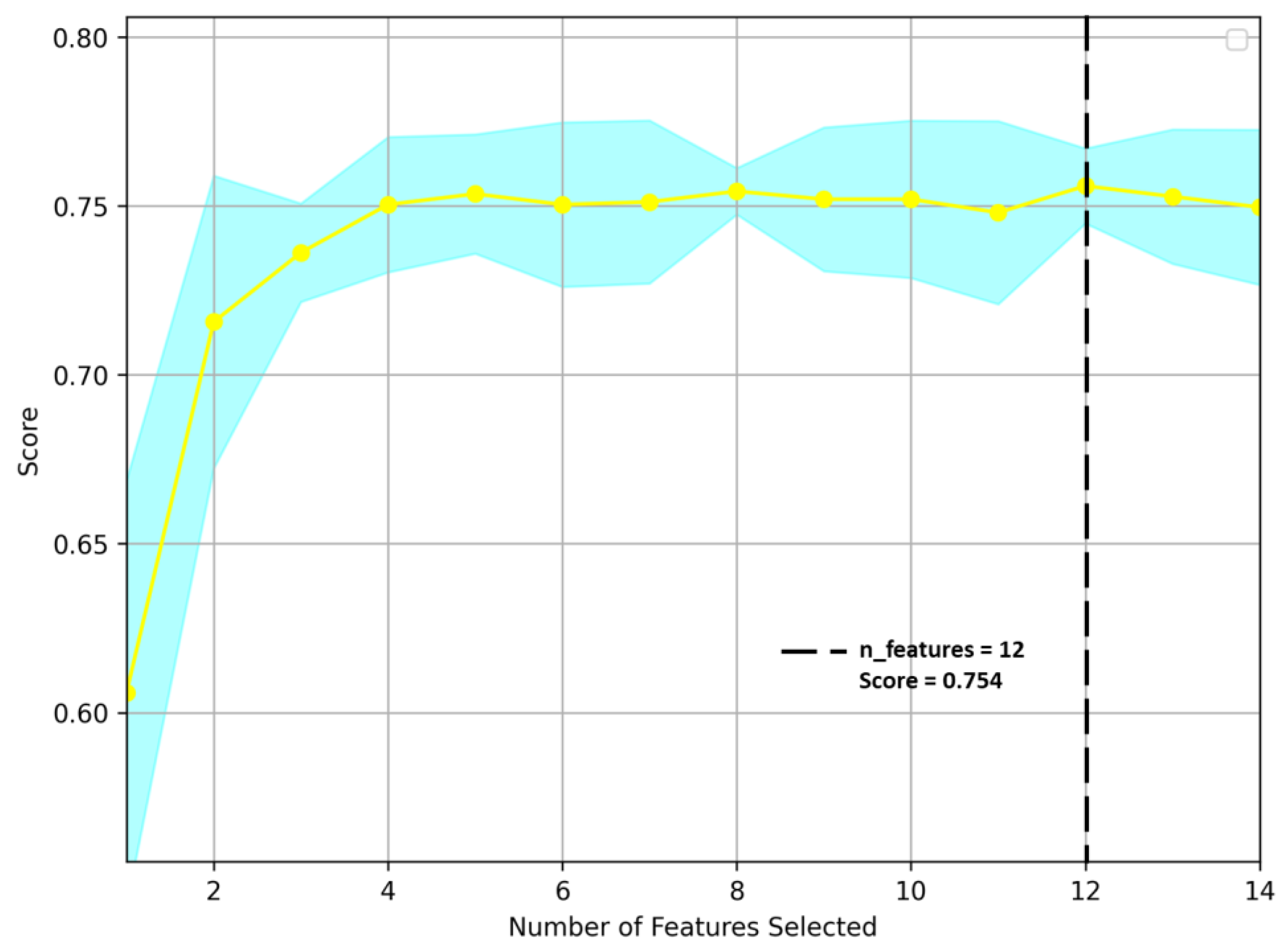
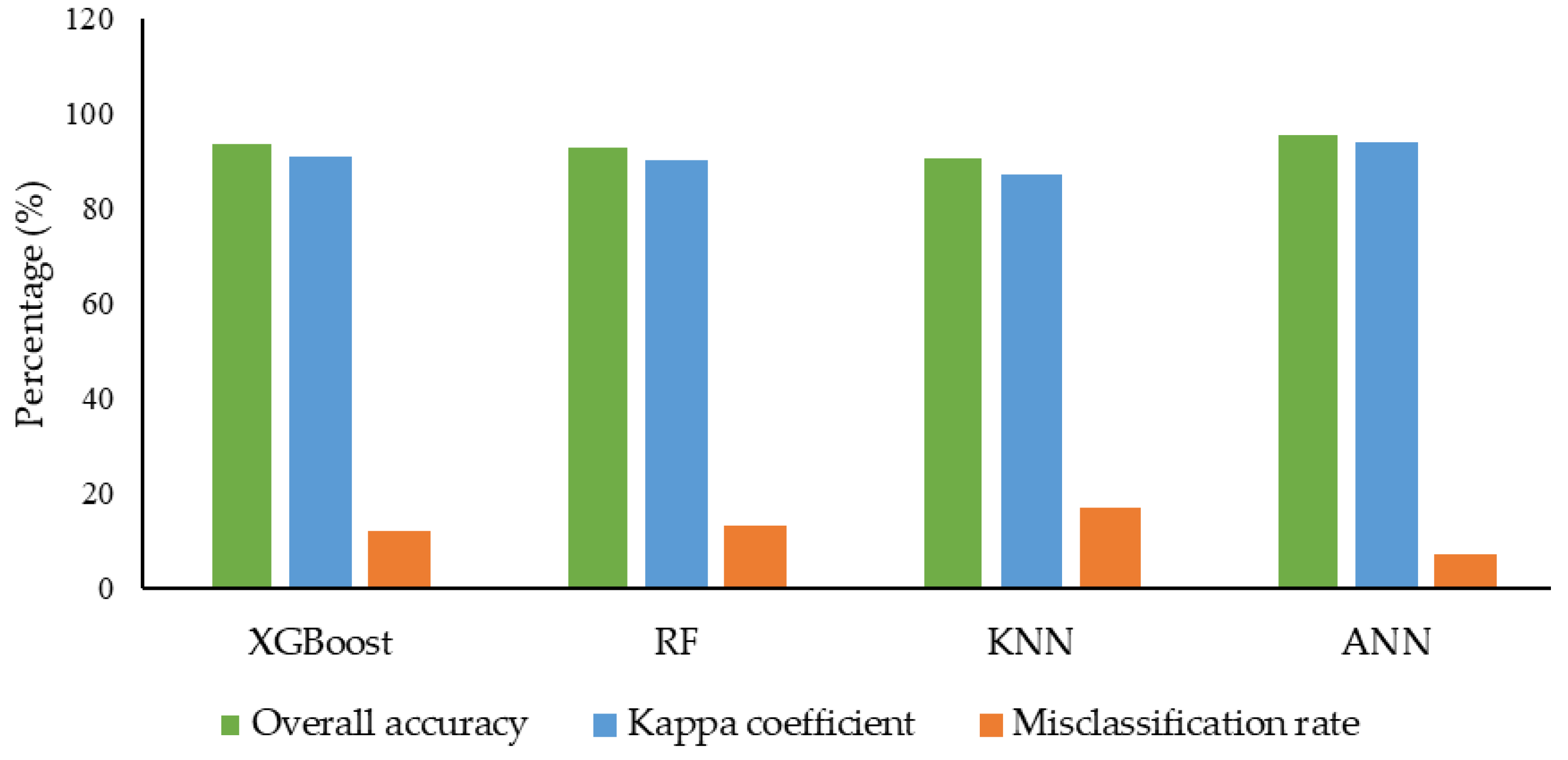
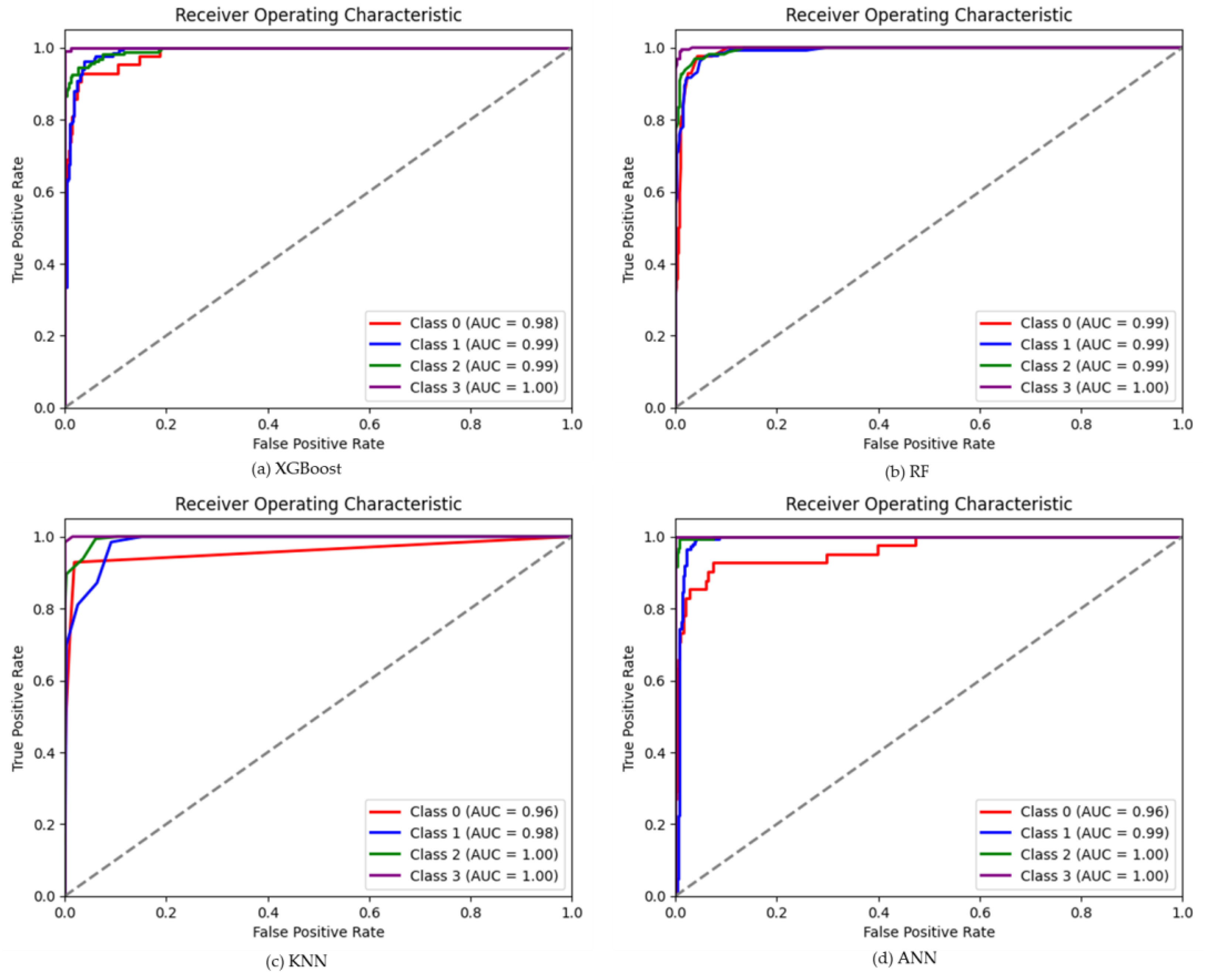
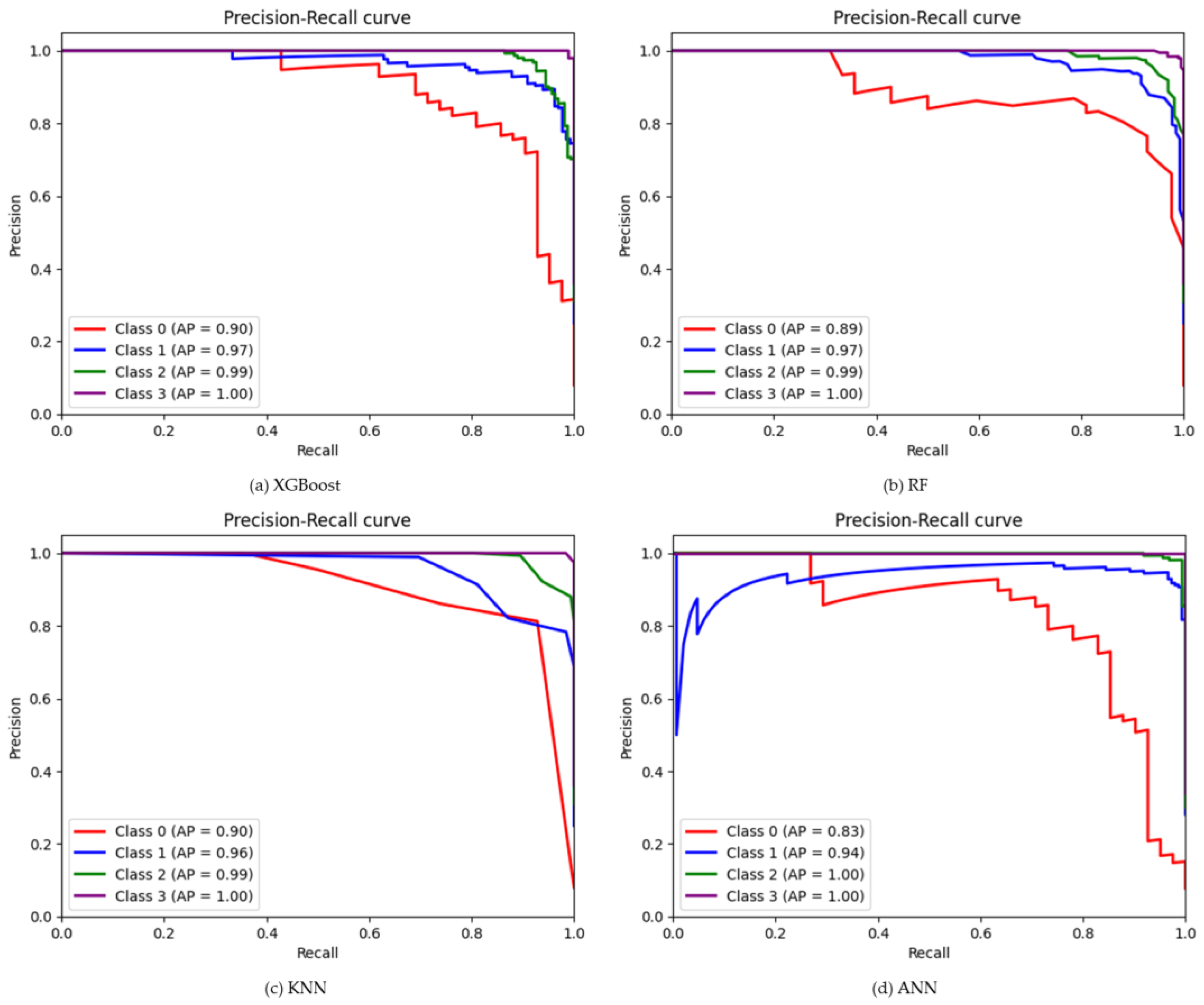


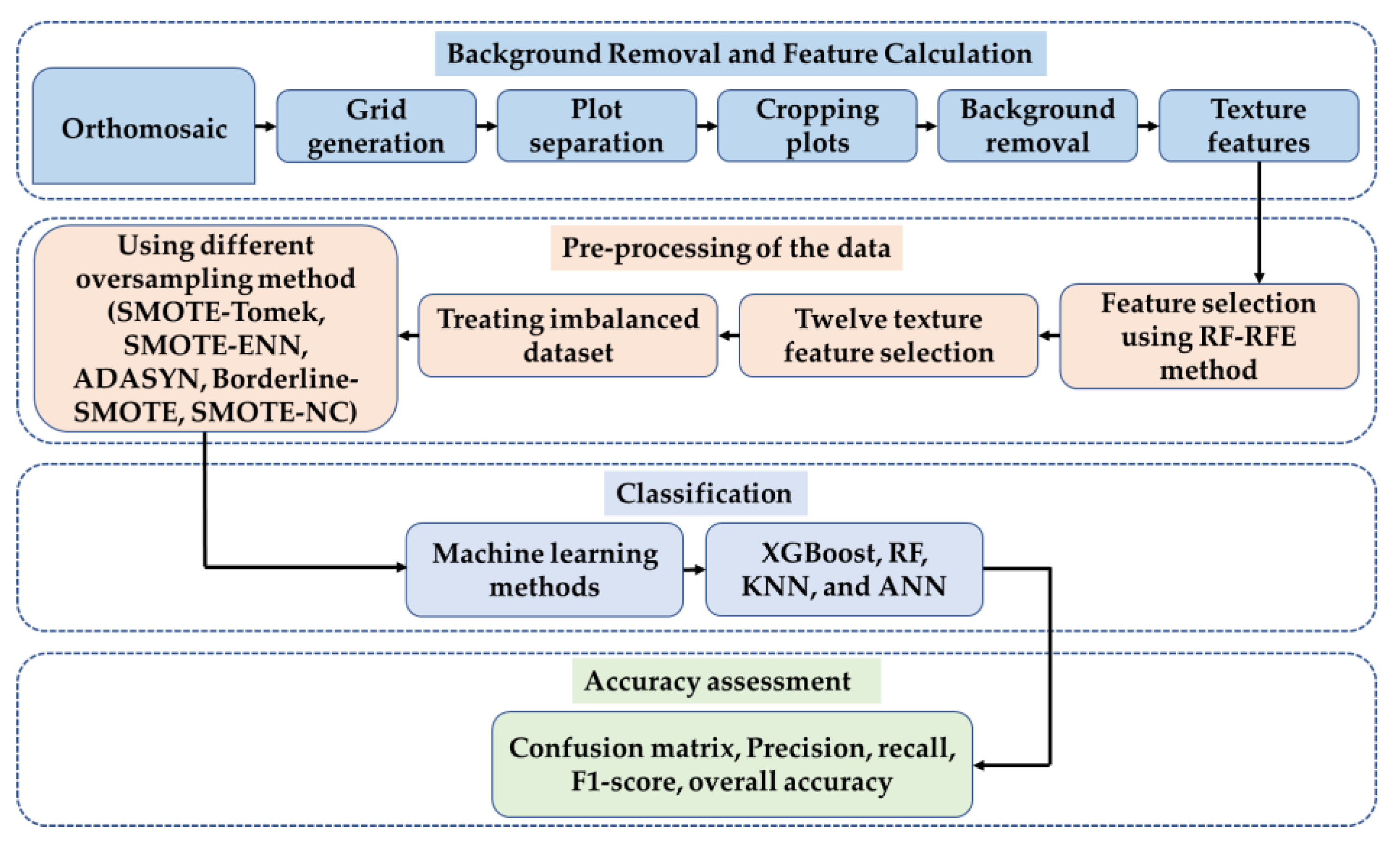
| Dataset | NL | ML | HL | SL |
|---|---|---|---|---|
| Original | 964 | 206 | 85 | 11 |
| SMOTE-Tomek Link | 923 | 964 | 964 | 964 |
| SMOTE-ENN | 224 | 700 | 784 | 925 |
| Borderline-SMOTE | 964 | 964 | 964 | 964 |
| SMOTE-NC | 964 | 964 | 964 | 964 |
| ADASYN | 964 | 976 | 966 | 962 |
| Classifier | Actual Samples | NL | ML | HL | SL | Precision | Recall | F1-Score |
|---|---|---|---|---|---|---|---|---|
| XGBoost | NL | 27 | 9 | 5 | 1 | 0.93 | 0.64 | 0.76 |
| ML | 1 | 127 | 4 | 0 | 0.87 | 0.96 | 0.91 | |
| HL | 1 | 9 | 153 | 0 | 0.94 | 0.94 | 0.94 | |
| SL | 0 | 1 | 1 | 188 | 0.99 | 0.99 | 0.99 | |
| RF | NL | 25 | 12 | 4 | 1 | 0.89 | 0.60 | 0.71 |
| ML | 3 | 123 | 4 | 2 | 0.87 | 0.93 | 0.90 | |
| HL | 0 | 6 | 156 | 1 | 0.94 | 0.96 | 0.95 | |
| SL | 0 | 0 | 2 | 188 | 0.98 | 0.99 | 0.98 | |
| KNN | NL | 23 | 17 | 1 | 1 | 0.92 | 0.55 | 0.69 |
| ML | 1 | 115 | 12 | 4 | 0.82 | 0.87 | 0.84 | |
| HL | 1 | 9 | 153 | 0 | 0.92 | 0.94 | 0.93 | |
| SL | 0 | 0 | 0 | 190 | 0.97 | 1.00 | 0.99 | |
| ANN | NL | 22 | 15 | 3 | 1 | 0.53 | 0.92 | 0.67 |
| ML | 1 | 147 | 0 | 0 | 0.99 | 0.91 | 0.95 | |
| HL | 1 | 0 | 158 | 0 | 0.99 | 0.98 | 0.98 | |
| SL | 0 | 0 | 0 | 179 | 1.00 | 0.99 | 0.99 |
| Crop/Land Cover | Phenotype/Dataset | Preprocessing | Analytical Method | Overall Accuracy | UAV Imagery Type | Reference |
|---|---|---|---|---|---|---|
| Other Researcher’s | ||||||
| Maize | Lodging | SMOTE-ENN | XGBoost | 94.5% | RGB | [47] |
| Wheat | Yield | Undersampling | RF | 99.78% | [48] | |
| Wheat | Yield | SMOTE | RF | 99.92% | [48] | |
| Three different land coverings | AVIRIS Indian Pines, Salinas Valley, Pavia University | SMOTE-Tomek Links | Rotation Forest (RoF) and Random Rotation Ensemble Forest (RREF) | 93.89% and 93.17% | Hyperspectral | [49] |
| Grass | Lodging | None | SVM | 79.1% | RGB | [50] |
| Maize | Lodging | None | MLC | 86.61% | Multispectral | [12] |
| Barley | Lodging | None | RF | 99.7% | Multispectral | [14] |
| Wheat | Lodging | None | SVM | 92.6% | MS | [34] |
| Rice | lodging | None | ANN | 97.8% | Hyperspectral | [51] |
| This study | ||||||
| Soybean | Lodging | SMOTE-ENN | XGBoost | 94% | RGB | This study |
| Soybean | Lodging | SMOTE-ENN | RF | 93% | RGB | This study |
| Soybean | Lodging | SMOTE-ENN | KNN | 91% | RGB | This study |
| Soybean | Lodging | SMOTE-ENN | ANN | 96% | RGB | This study |
| Texture Features | Equation | Reference |
|---|---|---|
| Angular second moment | Wheat, soybean, rice and maize classification [61] | |
| Contrast | Crop disease and different crop classification [61,62] | |
| Correlation | Weed classification, crop disease and different crop classification [61,62,63] | |
| Variance | Olive, potato, wheat, and sugar beet classification, weed classification, crop disease and different crop classification, and crop type mapping [61,62,63,64,65] | |
| Inverse difference moment | Land cover classification [66] | |
| Sum average | Poultry carcass identification [67] | |
| Sum variance | Poultry carcass identification [67] | |
| Sum entropy | Crop discrimination [68] | |
| Entropy | Crop classification using UAV multispectral imagery [69] | |
| Difference variance | Poultry carcass identification [67] | |
| Difference entropy | Poultry carcass identification [67] | |
| Information measures of correlation I | Plant identification [70] | |
| Information measures of correlation II | Plant identification [70] | |
| Maximal correlation coefficient | where, | Crop classification [71] |
Disclaimer/Publisher’s Note: The statements, opinions and data contained in all publications are solely those of the individual author(s) and contributor(s) and not of MDPI and/or the editor(s). MDPI and/or the editor(s) disclaim responsibility for any injury to people or property resulting from any ideas, methods, instructions or products referred to in the content. |
© 2023 by the authors. Licensee MDPI, Basel, Switzerland. This article is an open access article distributed under the terms and conditions of the Creative Commons Attribution (CC BY) license (https://creativecommons.org/licenses/by/4.0/).
Share and Cite
Sarkar, S.; Zhou, J.; Scaboo, A.; Zhou, J.; Aloysius, N.; Lim, T.T. Assessment of Soybean Lodging Using UAV Imagery and Machine Learning. Plants 2023, 12, 2893. https://doi.org/10.3390/plants12162893
Sarkar S, Zhou J, Scaboo A, Zhou J, Aloysius N, Lim TT. Assessment of Soybean Lodging Using UAV Imagery and Machine Learning. Plants. 2023; 12(16):2893. https://doi.org/10.3390/plants12162893
Chicago/Turabian StyleSarkar, Shagor, Jing Zhou, Andrew Scaboo, Jianfeng Zhou, Noel Aloysius, and Teng Teeh Lim. 2023. "Assessment of Soybean Lodging Using UAV Imagery and Machine Learning" Plants 12, no. 16: 2893. https://doi.org/10.3390/plants12162893
APA StyleSarkar, S., Zhou, J., Scaboo, A., Zhou, J., Aloysius, N., & Lim, T. T. (2023). Assessment of Soybean Lodging Using UAV Imagery and Machine Learning. Plants, 12(16), 2893. https://doi.org/10.3390/plants12162893







